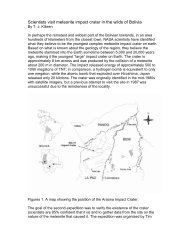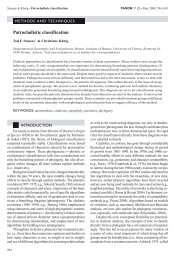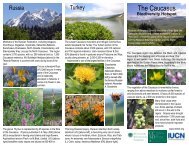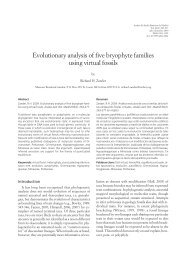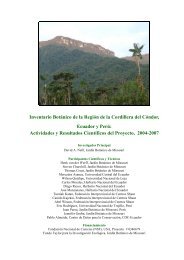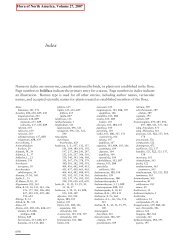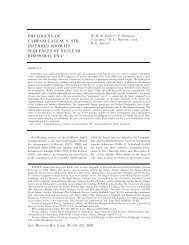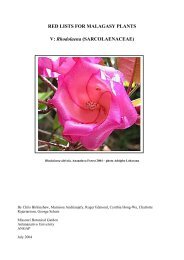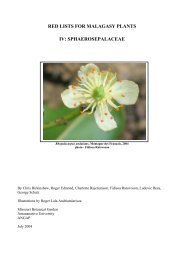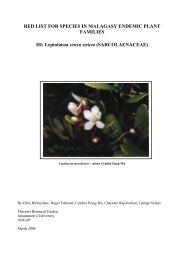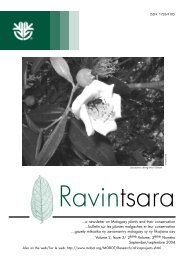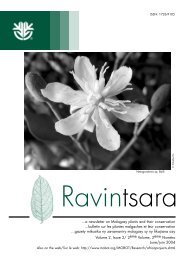re-evaluation of tortella - Missouri Botanical Garden
re-evaluation of tortella - Missouri Botanical Garden
re-evaluation of tortella - Missouri Botanical Garden
You also want an ePaper? Increase the reach of your titles
YUMPU automatically turns print PDFs into web optimized ePapers that Google loves.
26<br />
2. Leaf cells generally 14 µm; elongate, smooth ste<strong>re</strong>id cells exposed on the adaxial surface <strong>of</strong> the costa<br />
throughout the leaf length in all cauline leaves; plants <strong>of</strong> limestone pavements in the G<strong>re</strong>at Lakes <strong>re</strong>gion . . .<br />
. Tortella rigens<br />
2. Leaf cells to 12 µm or less, adaxial surface <strong>of</strong> the costa partially cove<strong>re</strong>d by quadrate, papillose<br />
epidermal cells in stem leaves, plants <strong>of</strong> North Temperate, Bo<strong>re</strong>al and Arctic distribution . . . . 3<br />
3. Leaves e<strong>re</strong>ct and stiff, lamina intact, leaf developing a morphologically distinct deciduous<br />
apical propagulum, leaves in section <strong>re</strong>gularly bistratose in the apical portion . . . . Tortella<br />
fragilis<br />
3. Leaves generally crisped, lamina tatte<strong>re</strong>d, leaf not developing an apical propagulum, me<strong>re</strong>ly<br />
disintegrating in pieces, leaves in section ir<strong>re</strong>gularly bistratose in patches . . . . Tortella tortuosa<br />
var. fragilifolia<br />
Specimens examined, with annotations:<br />
Alta: 6000 ft. (1820 m) in tundra, Crum & Sch<strong>of</strong>ield<br />
5742 (MICH, UBC) ( with ext<strong>re</strong>mely long,<br />
slender, tatte<strong>re</strong>d leaves to 7 mm).<br />
Alta: rather dry boulders near Athabasca Falls, 20 mi. S.<br />
<strong>of</strong> Jasper, 4100 ft. (1241 m), June 25, 1955, H.<br />
Crum 3700 (MICH); tundra, slopes <strong>of</strong> Forum<br />
Peak, above Cameron Lake, ca. 6000 ft. (2000<br />
m), Waterton Lakes National Park, July 30,<br />
1955, H. Crum & W. B. Sch<strong>of</strong>ield 5742<br />
(MICH).<br />
B.C.: outcrop c<strong>re</strong>vices Mt. Liumchen-Church Mt a<strong>re</strong>a,<br />
49°02'N, 121°50'W, Sch<strong>of</strong>ield 63200 (UBC).<br />
(The only thing to associate this specimen with<br />
the variety, other than general aspect, was the<br />
distal leaf cross section which displayed a<br />
brightly chlorophyllose adaxial epidermis<br />
covering the adaxial ste<strong>re</strong>id layer, this latter<br />
vanishing toward the apex, leaving the<br />
quadrate cells intact. The<strong>re</strong> was no central<br />
strand and the diameter <strong>of</strong> the stem in section<br />
was small).<br />
B.C.: Sn. Cariboo Mtns 52°N, 120°W., moist hummock<br />
on river sho<strong>re</strong>, distal Tsuga zone, Leena &<br />
Teuvo Ahti 13730 (UBC). (Identified by the<br />
leaf cross section: all leaves intact.)<br />
Alaska: southeast; above t<strong>re</strong>e line (2200–3160') on<br />
Harbor Mtn. above Sitka, Baran<strong>of</strong> I., mostly<br />
slopes <strong>of</strong> exposed rocks in heathers, shaded<br />
rock angle, Aug. 4, 1968, I. A. Worley & F. M.<br />
Boas 10066 (UBC).<br />
Calif.: Siskiyou Co., moist, rather shaded rock outcrop<br />
in seepage, in open alder, incense cedar and<br />
white fir fo<strong>re</strong>st on south slopes <strong>of</strong> Red Butte<br />
near Cook & G<strong>re</strong>en Pass, 6500 ft. (2170 m), 28<br />
Sept., 1977, D. H. Norris 50265 (UBC). (The<br />
specimen in leaf cross section had the quadrate<br />
adaxial epidermis intact, the adaxial ste<strong>re</strong>id<br />
disappea<strong>re</strong>d and some <strong>of</strong> the cells we<strong>re</strong> with<br />
bistratose patches, no stem central strand.)<br />
Wash.: North Cascades, Rainy Pass a<strong>re</strong>a, Lewis Glacier<br />
and Lake, subalpine meadows, seepy slope<br />
above lake, under water in temp. snowmelt<br />
st<strong>re</strong>am in subalpine, 48°N 121'W, June 29,<br />
1982, J. Spence 1077 (UBC).<br />
A form <strong>of</strong> variation seen in only one specimen<br />
was the p<strong>re</strong>sence <strong>of</strong> quadrate, chlorophyllose papillose<br />
cells on the back <strong>of</strong> the costa in the leaf apex (Alberta,<br />
Crum 3512 UBC) which was acicular and nearly<br />
cylindric. The<strong>re</strong> is a variety <strong>of</strong> Tortella nitida in Europe<br />
(var. irrigatum (Winter) Zand., see below) that has this<br />
featu<strong>re</strong>, but the specimen cited he<strong>re</strong> is the only occasion<br />
in T. tortuosa s.l. noticed in the p<strong>re</strong>sent study <strong>of</strong> this<br />
featu<strong>re</strong>.<br />
5. TORTELLA FRAGILIS Plate 6<br />
Tortella fragilis (Drumm.) Limpr., Laubm. Deutschl. 1:<br />
606. 1888.<br />
Didymodon fragile [sic] Drumm., Musci Amer.<br />
(Rocky Mts.) 127. 1828.<br />
Trichostomum fragile (Drumm.) C. Müll., Syn.<br />
Musc. 1: 586. 1849.<br />
Barbula fragilis (Drumm.) BSG, Bryol. Eur. 6:<br />
157. 1855 (fasc. 62–65 Mon. Suppl. 4:<br />
1.), hom. illeg.<br />
Tortula drummondii Mitt., Jour. Linn. Soc.<br />
London Bot. 1(Suppl.): 27. 1859.<br />
Mollia fragilis (Hook. & Wils.) Lindb., Musci<br />
Scand. 21. 1879.<br />
Plants coarse, rigid, dark g<strong>re</strong>en to yellowish or<br />
blackish-brown in dense tufts or deep sods, elongate.<br />
Stems (0.5–)1–5 cm high, leaves distantly disposed<br />
along the stem with shining leaf bases usually appa<strong>re</strong>nt,<br />
central strand absent, densely and visibly radiculose the<br />
enti<strong>re</strong> stem length, ra<strong>re</strong>ly somewhat tomentose when<br />
very small. Stem leaves firm, coarse, rigid, uniform in<br />
size and shape along the stem, not app<strong>re</strong>ciably larger at<br />
the stem apex, lowermost leaves mostly without leaf<br />
tips, leaves typically fragile only at base <strong>of</strong> deciduous<br />
apical subula, stiffly e<strong>re</strong>ct-app<strong>re</strong>ssed, incurved (or stemapical<br />
leaves somewhat twisted around the stem when<br />
dry); e<strong>re</strong>ct and weakly sp<strong>re</strong>ading when moist, narrowly<br />
lanceolate to linear, narrowing gradually above the<br />
proximal <strong>re</strong>gion until gradually or quickly contracting<br />
into a narrower propaguloid <strong>re</strong>gion up to 1/2 the distal<br />
leaf length; broadly to narrowly concave, keeled toward<br />
the apex in non-propaguloid leaves, 4–6 mm long; base<br />
broadly oblong; margins plane to e<strong>re</strong>ct, not to<br />
somewhat undulate; apex narrowly acute, those <strong>of</strong> nonmodified<br />
leaves shallowly channeled to subnaviculate,<br />
not cucullate, those <strong>of</strong> modified leaves long-subulate,<br />
fragile, the subula obtusely thickened and multi-stratose<br />
distally and <strong>of</strong>ten broken <strong>of</strong>f, youngest leaves arising





